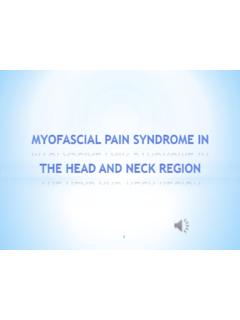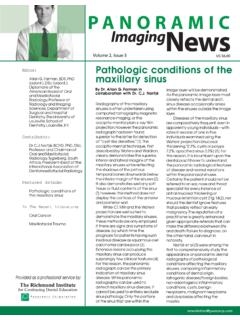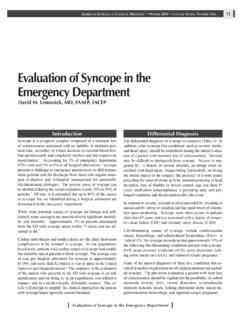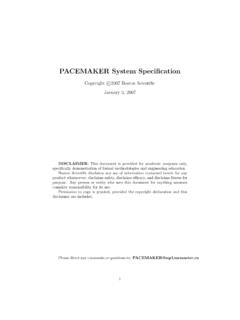Transcription of Chronic Fatigue Syndrome - - RN.org®
1 Chronic Fatigue Syndrome Reviewed October, 2019, Expires October, 2021 Provider Information and Specifics available on our Website Unauthorized Distribution Prohibited 2019 , , , LLC Overview of CFS Chronic Fatigue Syndrome is a debilitating and complex disorder characterized by profound Fatigue of at least 6 months duration that results in substantial reduction in occupational, personal, social or educational activities; the Fatigue is not improved by rest, may be worsened by physical or mental activities, and is accompanied by characteristic symptoms (impaired memory or concentration, unrefreshing sleep, post-exertional malaise, headaches, muscle pain, joint pain, sore throat and tender cervical/axillary nodes). These symptoms are discussed in detail in the Recognition and Diagnosis section of this course. Most CFS patients who seek medical attention from physicians and other members of the health care community often describe their illness as beginning suddenly over a period of hours or days.
2 In contrast, people with CFS who are identified in community studies more often report a gradual onset of illness over weeks or months. The clinical course of CFS frequently has an intermittent pattern of relapse and remission. As yet, there are no diagnostic tests or laboratory markers for CFS, and its pathophysiology remains unknown. Other diseases that could explain the symptoms of CFS must be identified and treated before a patient s condition can be diagnosed as CFS. This tenet is particularly important for behavioral and rehabilitative therapists because they may see persons with illnesses similar to CFS who may not have received an adequate medical or psychiatric evaluation. Various terms are often used interchangeably with CFS. CFS is the preferred term because it has an internationally accepted case definition that is used in research and clinical settings.
3 The name Chronic Fatigue and immune dysfunction Syndrome (CFIDS) was introduced soon after CFS was defined; there is no case definition for CFIDS, and the name implies an understanding about the pathophysiology of CFS that does not currently exist. Chronic active Epstein-Barr virus (EBV) infection ( Chronic mononucleosis) was thought to be the cause of CFS during the 1980s, and this association is now known to be rare. However, post-infection Fatigue syndromes have been associated with EBV and other infectious agents. The name myalgic encephalomyelitis (ME) was coined in the 1950s to clarify well-documented outbreaks of disease; however, ME is accompanied by neurologic and muscular signs and has a case definition distinct from that of CFS. Epidemiology Prevalence: Studies have found that 1% 2% of the general population suffers symptoms of CFS (Steele et al.)
4 , 1998; Jason et al., 1999; Reyes et al., 2003; Bierl et al., 2004) and that CFS can be confirmed in between and of adults (Jason et al., 1999; Reyes et al., 2003). More importantly, studies in Chicago and Wichita documented that only 10% 16% of individuals with CFS have been diagnosed by or treated for CFS by a medical professional (Kennedy et al., 2000; Reyes et al., 2003). The low rate of diagnosis highlights the need for increased awareness of CFS by health care providers throughout the health care system. Demographics: Recent studies have shown that much of the CFS patient stereotype of the last two decades is incorrect. Both the Chicago and Wichita studies found CFS to be 3 to 4 times more common in women than in men and found that CFS is most common in the 40 to 60 year age-range (although people of all ages may develop the disorder).
5 Both studies showed that CFS is significantly more common in persons with lower income levels. Finally, the studies also showed that non-Caucasian persons are as likely to have CFS as Caucasians. Studies currently underway will serve to update CFS demographics A Framework for Understanding CFS Although CFS has been studied internationally for almost two decades, there are still many questions and few definitive answers. This uncertainty is often a source of stress and anxiety as patients seek to understand their illness and its impact. Considerable information about CFS is available, especially on the Internet, but it is often not credible or accurate. Health professionals participating in the care and rehabilitation of people with CFS can assist them in developing a framework for understanding CFS, its contributing factors, possible causes and prognosis, all of which can facilitate feelings of control and hopefulness.
6 Causes and Contributing Factors: Many hypotheses concerning the causes and pathophysiology have been raised, but no conclusive evidence in support of any single cause of CFS has been found. Explanations have included central nervous system aberrations, immune system dysfunction, infectious diseases, psychiatric disorders, stress, hormonal disturbances and cardiovascular aberrations (Afari and Buchwald, 2003). One current view is that CFS has a variety of predisposing or associated factors that result in a recognizable pattern of symptoms and impairment. Proponents of this view have sought to study the origins of CFS by using a biopsychosocial model in which the body and mind influence each other's function and activity. This model includes three general factors involved in the onset and clinical course of CFS: Predisposing/risk factors are those that make a person more susceptible to CFS.
7 Triggering factors are those which, when experienced by a susceptible person, lead to the onset of CFS. Perpetuating factors are those that delay or prevent improvement. Essentially all studies have shown that women are more likely to develop CFS than are men. Physical and mental stress and acute infectious diseases have been associated with CFS, but the specific nature of their association (risk vs. triggering factors) is unknown. How risk factors impact responses to infections or other stressors that precede chronically fatiguing illnesses remains unclear. Finally, other conditions that occur in many individuals with CFS ( , sleep disorders, hormonal disturbances or psychiatric conditions) may represent co-morbid illness unrelated to CFS, may result from CFS, may be causally associated with risk of CFS or could share the same pathophysiologic pathways.
8 Effects of Exertion: Exacerbation and prolonged duration of symptoms following physical or mental exertion is one defining symptom of CFS, is reported by most patients, and is of particular importance to those responsible for therapy and rehabilitation of persons with CFS. As discussed later in this text, carefully designed and supervised rehabilitative therapy is important in the care management of CFS patients. Patients can learn to modify their activities to avoid post-exertional malaise and therefore improve their health status and function. Post-exertional exacerbation of the illness must be considered when developing intervention strategies for people with CFS. It is essential that rest and activity are balanced to avoid both deconditioning from lack of activity and flare-ups of illness due to overexertion. Recognition and Diagnosis Recognition and diagnosis of CFS can be challenging for health care practitioners.
9 Fatigue is a common symptom of many illnesses; between 10 and 25% of all patients who visit general practitioners complain of prolonged Fatigue (Hickie et al., 1999). Symptoms that comprise CFS are common in other conditions. However, there are distinct patterns and features of CFS that allow it to be differentiated from other medical and psychiatric conditions. Diagnosis of CFS can be made only after a thorough history, physical and mental status exam, and appropriate laboratory testing to rule out diseases that may be responsible for the patient s symptoms and for which specific treatment exists. CFS is essentially a diagnosis of exclusion. Health care providers from multiple disciplines may encounter CFS patients at any point in the evaluation and management process. Rehabilitation and behavioral professionals may see undiagnosed CFS patients who are seeking evaluation and treatment of pain disorders, poor physical function and mental health conditions ( , depression or somatization disorder).
10 These patients may also seek care to help them cope with interpersonal and lifestyle changes, lack of stamina or employment problems stemming from poor health. CFS patients may also have secondary mood symptoms, such as anxiety and depression, for which they seek evaluation and treatment. Patients who present with symptoms of CFS, but have not been evaluated, should be referred to a primary medical care provider. CFS Case Definition The International Working Group Case Definition of CFS (Fukuda et al., 1994) and clarifications published in 2003 (Reeves et al., 2003) provide the current international standard for diagnosis of CFS in research studies and provide appropriate guidelines for clinical diagnosis. CDC has developed an empirical case definition that addresses diagnostic and assessment needs in both the research and clinical arenas (Reeves et al.)
















